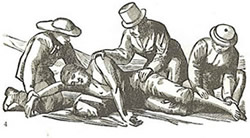Scots travelling in the 18th and 19th centuries could encounter all kinds of hardship and hazard. As well as ordinary illness and injury, there were riding and coach accidents, shipwrecks and even assault and robbery. While some travellers needing medical attention were treated by local doctors, others, including John Royston, sought hospital care.
John was a sailor on the brig Mary, one of many ships that sailed from Aberdeen and Peterhead to Greenland and the Davis Straits, to take part in whaling and seal-fishing. The ships’ crews were away from home for many months and John’s medical notes give us some idea of the conditions that the sailors often had to endure.
He was admitted to the Aberdeen Infirmary in November 1847, when the Mary arrived back from the Arctic. Four months into the voyage, some of the crew had developed scurvy and John was the first to show symptoms:
 His hand first grew stiff, hard and swollen, he found he was unable to straighten his legs as formerly; his knees were bent when he walked and when he moved the affected limbs he felt a sharp cutting pain in them. His right thigh then became affected in a similar manner and he observed the outside of his right knee present an appearance as if it had been bruised and pit deeply on pressure.
His hand first grew stiff, hard and swollen, he found he was unable to straighten his legs as formerly; his knees were bent when he walked and when he moved the affected limbs he felt a sharp cutting pain in them. His right thigh then became affected in a similar manner and he observed the outside of his right knee present an appearance as if it had been bruised and pit deeply on pressure.
While this would have made working difficult, worse was to follow:
He then began to have a very disagreeable taste in his mouth; his gums got swelled, livid, painful when touched and used to bleed profusely on the slightest pressure. His teeth became loose and he could scarcely eat any of the ship’s provisions, a little soaked biscuit or boiled rice being all that he could masticate. … on the way home he began to emaciate and get very weak and could rarely venture from his hammock a slight exertion sometimes making him faint.
On arrival in Aberdeen John applied to be admitted to the Infirmary. He had the classic symptoms of scurvy, a disease caused by a lack of vitamin C, and common in sailors whose ships did not carry vegetables or lime or lemon juice. He told the Infirmary doctor:
… the ship’s mess consisted of salt provisions, tea, coffee and the vegetable farinacea. They had no succulent vegetables on board, either fresh or pickled. They carried no lemon juice with them but used instead of it vinegar which however was only served out to those sick of scurvy. The men had a daily allowance of grog but got no beer.
In hospital John was prescribed red wine and was given plenty of vegetables at meal times. On 18 November, barely two weeks after admission, he was discharged ‘cured’. The Mary sailed for Greenland in 1848 and again in February 1849. This time she failed to return, being lost with all hands. It is not known if John Royston was then still one of the crew.
